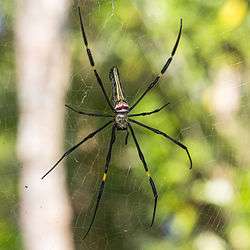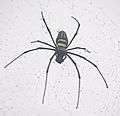Nephila pilipes
| Nephila pilipes | |
|---|---|
 | |
| Dorsal side Bantul, Indonesia | |
.jpg) | |
| Ventral side Bali, Indonesia | |
| Scientific classification | |
| Kingdom: | Animalia |
| Phylum: | Arthropoda |
| Class: | Arachnida |
| Order: | Araneae |
| Suborder: | Araneomorphae |
| Family: | Nephilidae |
| Genus: | Nephila |
| Species: | N. pilipes |
| Binomial name | |
| Nephila pilipes (Fabricius, 1793) | |
| Synonyms | |
|
Aranea longipes | |
Nephila pilipes (northern golden orb weaver or giant golden orb weaver)[1] is a species of golden orb-web spider. It can be found in Japan, China, Vietnam, Cambodia, Taiwan, Malaysia, Singapore, Myanmar, Indonesia, Thailand, Laos, Philippines, Sri Lanka, India, and Papua New Guinea. It is commonly found in primary and secondary forests and gardens. Females are large and grow to a body size of 30–50 mm (overall size up to 20 cm), with males growing to 5–6 mm. It is one of the biggest spiders in the world.
The Nephila pilipes' golden web is vertical with a fine irregular mesh and not symmetrical, with the hub usually nearer the top.[1] Rather than egg sacks being hung in the web, a pit is dug which is then covered with plant debris or soil.
The first, second and fourth pairs of legs of juvenile females have dense hairy brushes, but as the spider matures these brushes disappear.
Subspecies
- Nephila pilipes annulipes Thorell, 1881 – (Indonesia)
- Nephila pilipes flavornata Merian, 1911 – (Sulawesi)
- Nephila pilipes hasselti (Doleschall, 1859) – (Java)
- Nephila pilipes jalorensis (Simon, 1901) – (India, Sri Lanka)
- Nephila pilipes lauterbachi (Dahl, 1912) – (New Guinea)
- Nephila pilipes malagassa (Strand, 1907) – (Madagascar)
- Nephila pilipes novaeguineae (Strand, 1906) – (New Guinea)
- Nephila pilipes piscatorum Vis, 1911 – (Queensland)
- Nephila pilipes walckenaeri (Doleschall, 1857) – (Java)
Sexual dimorphism
Nephila pilipes display sexual dimorphism, the presence of distinct difference between the males and females of a species. In Nephila pilipes female spiders are much larger than their male counterparts,[2] and males can be 4-10 times smaller than the females.[3]
Sexual dimorphism appears to be a shared feature among Nephila pilipes spiders of different populations, as examinations of populations in Southeast Asia, Australia, and Papua New Guinea show similar patterns of size dimorphism.[4] Two major hypotheses have been suggested to explain this sexual selection and they are female gigantism and male dwarfism.
Female gigantism
One explanation for the dimorphism observed in the N. pilipes species is sexual size dimorphism may have evolved due to selection favoring female gigantism. Gigantism may have evolved in response to reduce the effectiveness of male mating plugs.[5] With a mating plug, male spiders ensure that only the male who create the plug post coitus would be the father of the resulting offspring.[5] Although in the species of N. pilipes, plugging does not seem to have an effect as females are still able to have successful matings even with multiple plugs.[5] The evolution of plugs occurred in earlier ancestral species and still persists along. These traits were then passed down to one of its decedents, the living species N. pilipes.[6] In this ancestral species, female gigantism was selected as a positive adaptation. In female spiders with larger bodies, the “embolic plugs” inserted in the N. pilipes females' genitalia become too thin to effectively seal the genitalia.[7] Additionally, female gigantism would have been important to the ancestral species at the time when mating plugs were still effective, as body size has been shown to increase fecundity.[8] By laying more eggs at a time, the ancestral females could have produced more offspring before they were plugged by a male.[4]
Female N. pilipes spiders are able to achieve a large size because they can continue to molt and grow after maturity.[2] This contrasts with most spiders, where growth stops once sexual maturity is reached. Female N. pilipes spiders will stop molting, however, during times of high copulation where it may not be advantageous to continue to grow as sperm are fertilizing eggs.[2]
Male dwarfism
Alternatively, sexual size dimorphism may have evolved due to selection favoring male dwarfism instead of female giganticism. An explanation of how dwarfism was selected for is due to scramble competition in which smaller male size in advantageous for reproduction. In N. pilipes spiders specifically, male spiders that were able to find female spiders first often fertilize a greater percentage of their eggs than other males.[9] Also, because female N. pilipes spiders often do not remain on their webs during sexual maturity, the smaller and more agile male spiders were able to reach them first, compared to the slower, larger males which often waited at the web of the female in advantageous spots.[9] This explanation means that smaller males had a greater fitness due to the behavior of the female spider to move around in maturity as compared to that of larger males who did not move as much and often copulated with females in their webs after smaller males had already done so.[9]
Different views and aspects
 Mating Nephila pilipes in Kaeng Krachan National Park, Thailand
Mating Nephila pilipes in Kaeng Krachan National Park, Thailand Northern Queensland, Australia
Northern Queensland, Australia_in_Kawal_WS%2C_AP_W_IMG_1531.jpg) Nephila pilipes jalorensis in Kawal Wildlife Sanctuary, India
Nephila pilipes jalorensis in Kawal Wildlife Sanctuary, India_in_Kawal_WS%2C_AP_W_IMG_1495.jpg) Nephila pilipes jalorensis in Kawal Wildlife Sanctuary, India
Nephila pilipes jalorensis in Kawal Wildlife Sanctuary, India Nephila pilipes in Noosa Heads, Queensland Australia
Nephila pilipes in Noosa Heads, Queensland Australia Juvenile Nephila pilipes
Juvenile Nephila pilipes Dorsal side of adult female Nephila pilipes in Taiwan
Dorsal side of adult female Nephila pilipes in Taiwan Nephila pilipes in Yangmingshan National Park, Taiwan
Nephila pilipes in Yangmingshan National Park, Taiwan
 Portrait of female in Bantul, Indonesia
Portrait of female in Bantul, Indonesia
Notes
- 1 2 Nephila pilipes, Arachne.org.au
- 1 2 3 Kuntner, Matjaž; Zhang, Shichang; Gregorič, Matjaž; Li, Daiqin (2012). "Nephila Female Gigantism Attained through Post-maturity Molting". Journal of Arachnology. 40.3: 345–347. doi:10.1636/b12-03.1.
- ↑ S., Mark; D., Andrew; A., Mark (2007). "The systematics and biology of the spider genus Nephila (Araneae:Nephilidae) in the Australasian region". Invertebrate Systematics. 21: 407–451.
- 1 2 Tso, I-Min; Shu-Ya, Chiang; Blackledge, Todd (2007). "Does The Giant Wood Spider Nephila Pilipes Respond To Prey Variation By Altering Web Or Silk Properties?.". Ethology. 113: 324–333. doi:10.1111/j.1439-0310.2007.01318.x.
- 1 2 3 Kuntner, Matjaž; Coddington, Jonathan; Schneider, Jutta (2009). "Intersexual Arms Race? Genital Coevolution In Nephilid Spiders (Araneae, Nephilidae)". Evolution. 63: 1451–1463. doi:10.1111/j.1558-5646.2009.00634.x. PMID 19492993.
- ↑ Coddington, Jonathan; Hormiga, G; Scharff, N. (1997). "Giant female or dwarf male spiders?". Nature. 385: 687–688. doi:10.1038/385687a0.
- ↑ Kuntner, Matjaž.; Kralj-Fišer, S.; Schneider, Jutta; Li, Daiqin (2009). "Mate Plugging Via Genital Mutilation In Nephilid Spiders: An Evolutionary Hypothesis". Journal of Zoology. 277: 257–266. doi:10.1111/j.1469-7998.2008.00533.x.
- ↑ Legrand, Rebecca; Morse, Douglass (2000). "Factors driving extreme sexual size dimorphism of a sit-and-wait predator under low density". Biological Journal of the Linnean Society. 71: 643–664. doi:10.1006/bijl.2000.0466.
- 1 2 3 Danielson-François, Anne; Hou, Chueh; Cole, Nina; Tso, I-Min (2012). "Scramble Competition For Moulting Females As A Driving Force For Extreme Male Dwarfism In Spiders". Animal Behavior. 84: 937–945. doi:10.1016/j.anbehav.2012.07.018.
References
- A Guide to Common Singapore Spiders
- Colourful Orb-Weaving Spiders
- Nephila of Southern Africa
- Golden Orb web-spiders in south Thailand
External links
 Media related to Nephila pilipes at Wikimedia Commons
Media related to Nephila pilipes at Wikimedia Commons Data related to Nephila pilipes at Wikispecies
Data related to Nephila pilipes at Wikispecies